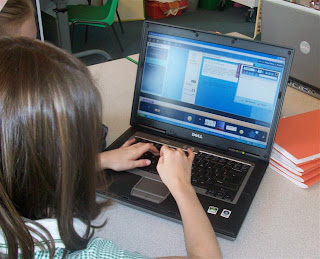To begin this morning we read together and shared the comments and advice we had left for William, Greg and Claire in our previous sessions using the Honeycomb Worry Website as a shared text. The children were asked to work in pairs to identify the ideas that they thought the characters might find helpful, and then to work with me as a class to create a model opening for a letter to one of the characters. Prior to the session I had created a Smart Board Notebook, that divided the letter into the three sections I wanted the children to use in framing their response, within this I provided sentence/paragraph openers that they could choose from, to discuss and develop as they wrote.
Using their Asus Web books in pairs the children were asked to open the wordprocessing package "write" to create their own advisory letters to the story character of their choice. They were allowed to "steal" openers if they felt they needed to and encouraged to use, add to expand and improve the ideas modelled by their friends to support the advice they gave. Throughout the session the students were stopped and encouraged to read aloud their letters as they developed. Suggestions were sought as to where they might go next, while this process also offered opportunities for other children to reread, review and edit their works in progress in response to what they had heard.
To end the session students were asked to attach and send their letters by email to me for moderation, review and printing. As web books the Asus Ees do not have a direct connection to our school network or print solution, they are intended to be used to support use of local applications alopngside the online learning tools and storage spaces we are providing such as the VLE. Drop boxes are the main vehicle for doing this in our current environment, however as I have mentioned in previous posts I really want the students to see our VLE as just this a Virtual Learning Environment, and a social tool to boot. The drop box approach seemed somehow not quite right contextually for this activity and the type of work the children have engaged in. The emails and letters are currently sitting in my inbox, awaiting a response. Being concerned not to lose the enthusiasm that this process has evoked, I am thinking after all their hard work that the pairs of students should recieve a reply from the characters they have sought to help. This should not be too difficult or time consuming, drafting a short standard reply from each character, that can be copied, pasted and edited to provide a little personalisation . Keeping the children hooked in this way I hope will be a really cool in and starting point to the next phase of our writing process which will involve the children using the ideas we have developed empathetically to write their own dilema based stories on these characters and evolving around similar themes. It will be interesting to see what response having an email from either Wiliam, Claire or Greg will have on Monday Morning. Hopefully next week we will be able to upload our letters to the class blog and share some of the outcomes. In the mean time here is a taster offered by two of the boys...
Dear Greg
We are sorry to hear that you have been having girl problems. This is something we don't usually have. We both have a sister and know all about the problems that girls can cause.
Why don't you start by talking to her at lunchtime. You can find out about her and see what she is in to. After that you can ask her out then if she says yes, you can take her on a date somewhere she might like to go. Perhaps you could go to the movies or for a walk in the park.
Good Luck
J and B
I wish I'd had friends like them when I was at Primary school.
Previous Posts
- Honeycomb 4: Thinking Through an Online Role Play Project
- Honeycomb 5: Beginning our Role Play Task
- Honeycomb 6: Collecting Ideas For Empathetic Writing








